Author: First.VIP Source: medium
Merit Circle (MC) is a decentralized DAO chain game guild built on Ethereum and BSC. Different from traditional chain game guilds, Merit Circle invests in the primary market of chain games, cooperates in game development, and builds chain game market distribution channels. Platforms, infrastructure construction and other methods have gradually expanded to the upper and middle reaches of the chain gaming industry. In summary, this project deserves attention.
Investment Summary
Merit Circle (MC) is a decentralized DAO chain game guild built on Ethereum and BSC. Initially, Merit Circle was a scholarship guild similar to YGG. It also has scholarship business, SubDao model, etc., but considering the credibility of the scholarship business, Due to the sustainability and limitations, these businesses were almost suppressed by YGG. In March 2022, it began to transform the structure and positioning of DAO, hoping to build it into a game DAO. Merit Circle divides DAO into multiple sectors (vertical fields). Currently, its main sectors are investment, studio (building and incubating new projects), games (chain game market distribution channel platform) and infrastructure (Beam based on Avalanche Game Chain, the mainnet was launched on August 18 this year), and the game NFT platform Sphere, which is still in the research and development stage, was once one of the four major sectors. Due to market factors, the release was delayed and replaced by the infrastructure sector.
Merit Circle, formerly known as Axie 420, is an Axie infinity "scholarship" organization. It was founded in July 2021. The original purpose was to enable players in low-wage countries to play Axie infinity. Axie 420 received US$200,000 in incubation investment from Flow Ventures in August 2021, and raised US$1.25 million from other channels. It was renamed Merit Circle in September 2021, expanding the project positioning from just focusing on Axie infinity to more of popular games and metaverse.
The advantages of Merit Circle are:
1) The treasury has sufficient funds and transparent information disclosure, and the allocation of funds is relatively reasonable (according to official treasury data, as of June 23 this year: cash accounts for 40%; highly liquid blue-chip tokens account for 8%; NFT assets account for 4% ; The tokens/equities related to the chain game track account for 48%, of which the primary market equity accounts for the majority, and the investment targets are mostly traditional game studios that combine blockchain technology, and the overall game style is more biased towards game playability), Treasury funds are approximately US$94.1 million, of which $MC is not included in treasury calculations. Treasury funds have decreased by approximately 7% compared to the end of 2021. In a bear market, Merit Circle ensures sufficient cash flow through reasonable treasury allocation, and has the theoretical ability to cope with the bear market in terms of funds.
2) Compared with traditional chain game guilds, Merit Circle’s development route is quite different. Merit Circle abandoned the scholarship model and invested in the primary market of chain games, cooperated to develop games, built game market distribution channel platforms, and built foundations. Facilities and other means are gradually extended to the upper and middle reaches of the chain gaming industry.
The risks of Merit Circle are:
1) Judging from the investment situation, Merit Circle invests mostly in the primary market of chain games, accounting for approximately 80% of the token/equity investments related to the chain game track. Merit Circle's income method is relatively single, mainly relying on the investment sector. Most of the gamefis invested by Merit Circle are small games, and the market value of the investment part is relatively large. The survival rate of this type of chain games in the bear market is low, and the risks and uncertainties are Greater certainty. Merit Circle's short- and medium-term revenue situation is difficult to improve due to market conditions. The follow-up depends on the development of the chain game track and whether the games invested can have good returns, as well as whether the constructed Beam game chain and the soon-to-be-released game NFT market Sphere can have good returns. good development.
2) The market value of $MC has a strong correlation with the market value of treasury assets under management, and the ceiling expectations appear to be relatively limited for the time being.
3) Due to the lack of attractive gold mining business and community activities, Merit Circle’s community foundation is relatively weak.
Note: The final assessment of [Follow]/[Not Follow] for the first-class warehouse is the result of a comprehensive analysis of the current fundamentals of the project in accordance with the first-class warehouse project evaluation framework, rather than a prediction of the future price rise or fall of the project token. There are many factors that affect the price of tokens, and project fundamentals are not the only factor. Therefore, just because the research report is judged as [not paying attention], it does not mean that the project price will definitely fall. In addition, the development of blockchain projects is dynamic. If a project judged by us to be "not concerned" undergoes significant positive changes in its fundamentals, we may adjust it to "concerned". Likewise, if a project judged by us to be "not concerned" If a project that is [Follow] undergoes major malignant changes, we will warn all members and may adjust it to [Not Follow].
1. Basic overview
1.1 Project Introduction
Merit Circle (MC) is a decentralized DAO chain game guild built on Ethereum and BSC. Its main sections are divided into investment, studio (building and incubating new projects), games and infrastructure (Beam built on Avalanche Game Chain, the mainnet was launched on August 18 this year). In addition, Merit Circle also launched its own NFT collection Edenhorde, as well as the game NFT platform Sphere, which is in the research and development stage.
1.2 Basic information

2. Project details
2.1 Team
According to LinkedIn data, the Merit Circle team has a total of 33 members. From the perspective of team background, team members generally have a blockchain work background. The core members have been deeply involved in Axie Infinity and have a background in web3 investment institutions.
Marco van den Heuvel — Co-founder, graduated from Arnhem Business School in International Business and Languages in 2019. From 2017.09 to 2018.10, he co-founded a blockchain company called Happy Mod, focusing on providing community management and marketing services for blockchain startups; in 2021.07, he founded the Axie 420 "scholarship" organization, which was renamed Merit Circle in 2021.09.
Tommy Quite — Co-founder, graduated from Beijing University of Technology with a major in Contemporary Chinese Business and Languages, and a major in Entrepreneurship and Small Business Operations from Utrecht University of Applied Sciences in the Netherlands. From 2014.04 to 2018.09, he was a member of the Bitcoin Foundation, committed to advocating and publicizing Bitcoin and blockchain technology; from 2017.07 to 2019.08, he worked at Civic, a Web3 identity management tool provider, as a community administrator; in 2020.12, he co-founded a company called Flow Ventures web3 venture capital institution; co-founded Merit Circle in 2021.08.
Mark Borsten — co-founder (Twitter @meritcirclorr, profile not published on LinkedIn), COO and co-founder of Flow Ventures, joins Merit Circle along with Tommy Quite.
Thale Sonnemans — Chief Operating Officer, COO, graduated from San Francisco State University with a major in marketing management and a major in business administration from Hann University of Applied Sciences in the Netherlands. From 2012.07 to 2013.07, he worked as a junior producer and junior sales representative at HALAL (a film production company and photography agency) from 2016.01 to 2018.12; from 2019.04 to 2021.10, he co-founded a gambling subsidiary company called Chaser; and joined Merit Circle in 2021.08.
Brandon Aaskov — CTO chief technology officer, graduated from the New England Institute of Art with a major in interactive media design. From 2006.02 to 2013.03, he worked at a streaming media technology company called Brightcove as a senior solution engineer; from 2015.06 to 2023.02, he worked at a software product agency called DEPT®, serving as software engineer, network director, cryptocurrency department manager and web3 deputy President and other positions; joined Merit Circle in 2023.02.
2.2 Funds
2.2.1 Financing
Merit Circle has received a total of 3 rounds of financing (the predecessor, Axie 420, received US$200,000 from Flow Ventures incubation investment in August 2021, and raised US$1.25 million from other channels).
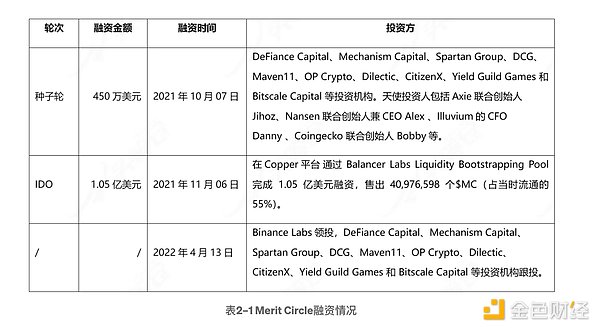
2.2.2 Treasury
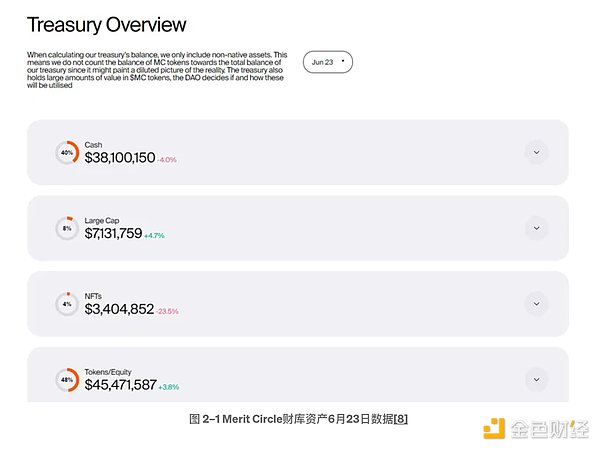
Merit Circle's treasury is divided into four parts (excluding $MC held), which are cash, blue chip coins, NFT assets, and tokens/equities related to the chain game track. The treasury value is approximately US$94.1 million. In addition, according to official treasury address statistics, Merit Circle’s treasury addresses on Ethereum and BSC hold a total of approximately 42.49 million $MC, which is approximately US$12.83 million based on the current currency price, accounting for approximately the current total circulation. 9.17%.
2.3 Code
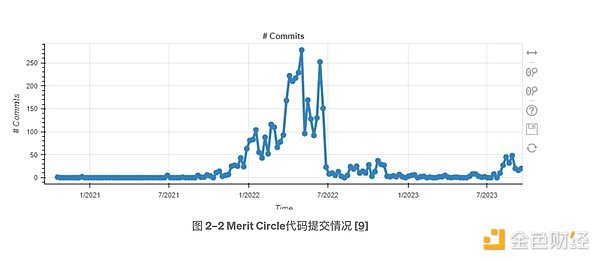
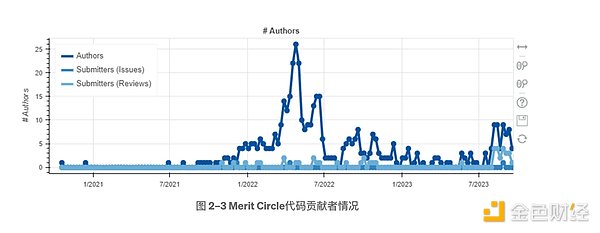
Merit Circle's code is open source on GitHub, with a total of 4,578 code submissions and an average of 10 code contributors. Among them, the time periods for more frequent code submissions are from March 2022 to June 2022, and from July 2023 to September 2023. These two periods correspond to the development of the game NFT market Sphere (not yet released, news was revealed in February Will be released this year) and develop the Beam game chain based on Avalanche Subnet.
2.4 Products
2.4.1 Product Introduction
Merit Circle (MC) is a decentralized DAO chain game guild built on Ethereum and BSC. Initially, Merit Circle was a scholarship guild similar to YGG. It also has scholarship business, SubDao model, etc., taking into account the sustainability of the scholarship business Due to its nature and limitations, the structure and positioning of DAO will begin to change in March 2022, hoping to create a game DAO and divide the DAO into multiple sectors (vertical fields). At present, its main sectors are divided into investment, studio (building and incubating new projects), games (chain game market distribution channel platform) and infrastructure (Beam game chain based on Avalanche, mainnet launched on August 18 this year), in addition The game NFT platform Sphere, which is still in the research and development stage, was once one of the four major sectors. Due to market factors, its release was delayed and replaced by the infrastructure sector.
2.4.2 Merit Circle Investment
1) Initial investment funds and sources;
Merit Circle's investment funds come from the US$100 million USDC previously raised on the Copper platform. According to the MIP-2 proposal, an investment committee was formed to be responsible for the investment. The specific members are: Flow Ventures LP, Sergei Chan, CitizenX and Maven11.
2) Investment details;
The details of Merit Circle’s investment sector are reflected in the treasury allocation. According to the data from the treasury as of June 23: cash distribution is mainly USDC; blue chip coins are mainly WBTC, Uni V2 pledge and WETH; NFT assets are mainly Bigtime Land ($1 million), Axies NFT and Cyball NFT; chain game competition Dao-related tokens/equities have invested in a total of 79 projects (61 non-circulating, 18 circulating), among which are mainly the primary market of chain games, accounting for about 80% of the chain game track-related tokens/equity investments. These The style of the game is more playable.
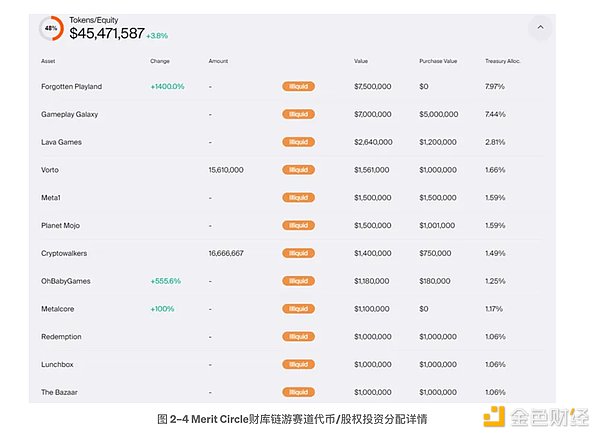
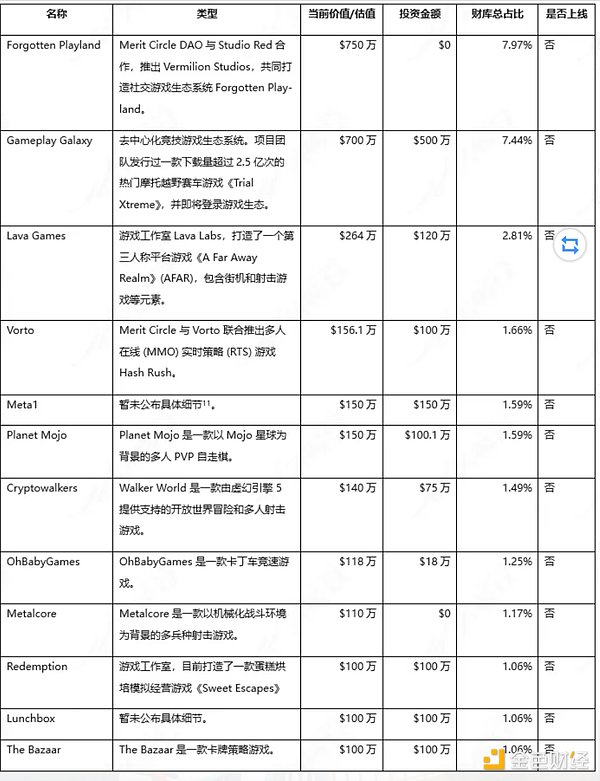
According to official data, the amount spent on the purchase of NFT assets was US$4,834,000, and the current valuation is US$3,404,852, with a loss of US$1,429,148 (-29.6%); the money spent on token/equity investment related to the chain game track was 28,045,486 US dollars, the current valuation is US$45,471,587, and the profit is US$17,426,101 (+62.1%). The above data is not accurate. Due to liquidity of NFT assets, the actual valuation will be lower. The valuation calculation of tokens/equities related to the chain game track is based on market valuation, and most assets are not circulated, so there is a certain degree of error.
Since the investment sector is the main source of income for Merit Circle, and the market value of $MC has a strong correlation with the market value of the treasury assets under management, it is necessary to focus on analyzing the health of the projects it invests. The following is a list of treasury accounts for more than 1% Current status of the project:
① Forgotten Playland, currently valued at $7.5 million, accounting for 7.97% of the total treasury
Merit Circle announced on April 25 this year that it would cooperate with Studio Red to launch Vermilion Studios to create the social game ecosystem Forgotten Playland. It has currently revealed two mini-games, one of which is called "Bomb Pitchers". The game content is roughly about players interacting with each other. Throw bombs in an attempt to blow up your opponents while avoiding being blown up yourself. Power-ups are scattered throughout the game, allowing players to make bombs more deadly with bigger explosions and other enhancements; another game, called Toy Limb Golf, is a golf game where players must run to equipment warehouses and find Weird items like toy limbs, baseball bats, and even a science fiction teleporter gun to use as their "golf clubs." Officials stated that 20 mini-games will be launched in the future. According to the disclosed information, Forgotten Playland’s game economy is mainly the sale of customizable skin NFTs, such as cosmetics, skins, etc. Judging from the official Twitter of Forgotten Playland, there have been no tweets or related progress disclosures since Merit Circle was announced on April 25. Therefore, the author believes that the game’s current valuation of $7.5 million has a lot of water, poor health, and Most of the games developed are small games, and the economic models are relatively general. The possibility of future development is currently not high.
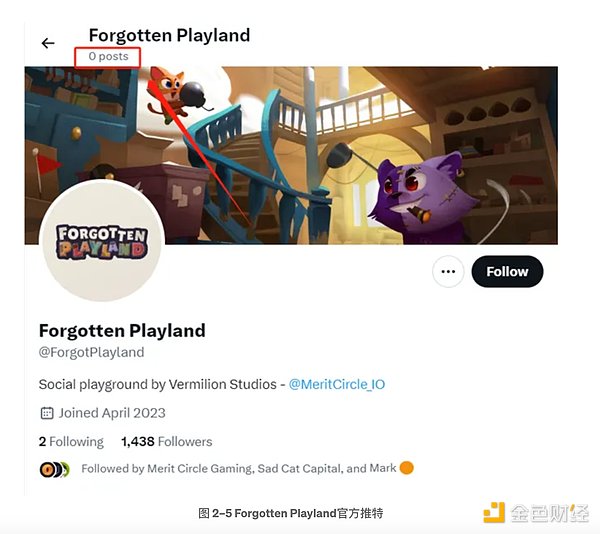
Judging from the official Twitter of Forgotten Playland, there have been no tweets or related progress disclosures since Merit Circle was announced on April 25. Therefore, the author believes that the game’s current valuation of $7.5 million has a lot of water, poor health, and Most of the games developed are small games, and the economic models are relatively general. The possibility of future development is currently not high.
② Gameplay Galaxy, currently valued at $7 million, accounting for 7.44% of the total treasury
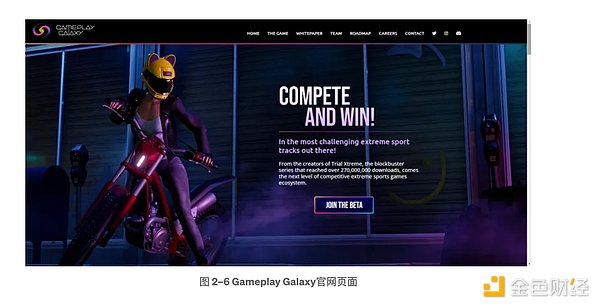
Gameplay Galaxy is a decentralized competitive gaming ecosystem powered by Web3, developed by the creators of the web2 game series Trial Xtreme, whose various bike racing games have been downloaded over 250 million times on Google Play and App The ratings on the Store are 4 stars and 4.2 stars respectively (out of 5 stars). Gameplay Galaxy raised $12.8 million on September 7, 2022, led by Blockchain Capital, with participation from Merit Circle (investing $5 million), Mysten Labs, Solana Ventures, Com2uS, Yield Guild Games and Hustle Fund.
According to LinkedIn data, the team behind Gameplay Galaxy currently has 41 employees. Co-founders Doron Kagan, Maya Gurevich and Dmitry Burlakov all have more than 15 years of game entrepreneurship and work experience.
Gameplay Galaxy has migrated its web2 game "Trial Xtreme" to web3. It is currently in beta testing version. You can apply for testing qualifications through email. Gameplay Galaxy has not yet issued coins, and the project white paper has not yet introduced details. According to the project roadmap, regular game updates such as the rarity and practicality of NFT, opening of early access versions, security reviews, localization in different regions, official release of the game, and the launch of the NFT owner community will be announced in the future.
Gameplay Galaxy's official Twitter (@TrialXtreme) has 17,577 Followers and is still actively tweeting updates. The official Medium of Gameplay Galaxy has not released any new content since the announcement on May 30.
As far as the background of the game project is concerned, Gameplay Galaxy's game "Trial Xtreme" has a certain degree of popularity and influence. The game has a history of more than ten years since its release in 2009 and is one of the more well-known early motorcycle racing games. , belongs to a niche direction in the game genre, with a stable player base, but there is still a certain gap between mainstream popular games; in terms of team background, the co-founders of Gameplay Galaxy have more than 15 years of game entrepreneurship and work experience; In terms of funds, $12.8 million is still enough to support this small game, because the game has been maturely running in web2 for many years. Based on the above information, the author believes that the health of this project is pretty good. Although the probability of it becoming a popular hit is low, it has a relatively solid foundation.
③ Lava Games, currently valued at $2.64 million, accounting for 2.81% of the total treasury
Lava Games is a game studio that has created a third-person platform game "A Far Away Realm" (AFAR), which includes arcade and shooting game elements. Merit Circle announced its cooperation with "A Far Away Realm" (AFAR) on March 21, 2022, and invested $1.2 million in it.
The game started soft launch for pre-registration on Google Play on June 30 this year, but it is still not online yet. Its project NFT collection AFAR — RAFA Genesis has only a trading volume of 90 ETH on OpenSea, and the current floor price is 0.0099 ETH, which is basically uninterested. In addition, the game's official Twitter (@playafar) has 46,451 followers, but its tweeting activity is low. Based on the above information, the author believes that the health of the project is poor, and the current valuation of $2.64 million is quite flawed.
④ Vorto, currently valued at $1.561 million, accounting for 1.66% of the total treasury
Merit Circle announced on August 25, 2022 that it would jointly launch the multiplayer online (MMO) real-time strategy (RTS) game "Hash Rush" with Vorto and invest $1 million in it. The game is currently in the development stage, and the official website states that it will be released on the Beam chain later. According to the officially revealed game animations and graphics, the production is relatively average. It is worth noting that the project has been in progress since July 2017, with intermittent progress and frequent changes in direction. In addition, the official Twitter (@PlayHashRush) has only 9,117 Followers. Based on the above information, the author believes that the health of the project is poor, and the current valuation of $2.64 million is quite flawed.
⑤ Others
Looking at other projects in general, it is found that most of the gamefi invested by Merit Circle are small games. The survival rate of such chain games in the bear market is low. At present, nearly half of the assets of the treasury are used to invest in gamefi projects. If you fail to invest in a hot money, it will be a potential risk for the project as a whole.

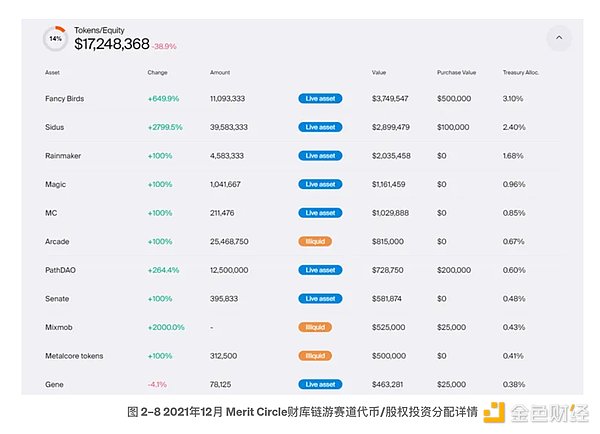
As shown in Figure 2–7, Merit Circle’s overall treasury shrinkage was not obvious during the market down cycle from 2021.11 to 2023.06. It decreased by approximately 7% compared to November 2021. According to analysis, the main reasons are as follows:
① Cash allocation has been maintained at around US$40 million, accounting for 40%-50% of the treasury;
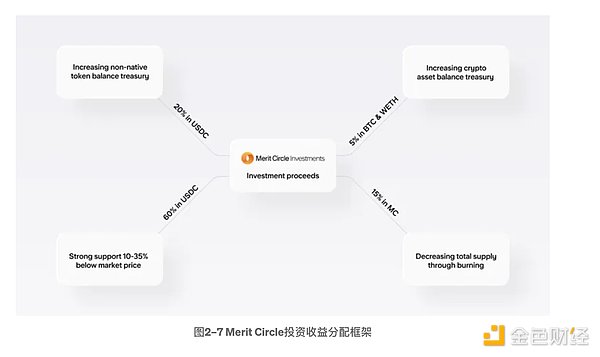
② NFT assets with large fluctuations and poor liquidity have remained at a low level, around 5%;
③ According to the risk aversion authorization in the early stage of the proposal MIP-6, a series of stop-profit and stop-loss requirements are proposed;
④ The risk assets of chain game track tokens/equities are mostly invested in the secondary market at the end of 2021 and the beginning of 2022 (as shown in Figure 2-8). In the early stages of the down cycle, the positions of this part of assets are intentionally reduced and turned to Invest in the primary market of chain travel circuits, and the proportion of investment is increasing month by month. In addition, it is worth noting that the quality of the projects invested in this part of investment assets is relatively average, most of them are small games and almost none of them are online, and their valuations are relatively high.
It can be seen from the above that Merit Circle is more conservative in its investment style and has a strong risk awareness, but the valuation of its investment projects is relatively high.
3) Investment income distribution.
According to the MIP-7 sustainable future vision proposal, the investment income distribution framework is formulated as shown in Figure 2-7, specifically:
① 20% of the proceeds will be returned to the treasury in the form of USDC;
② 5% of the proceeds will be returned to the treasury in the form of crypto assets (mainly ETH and WBTC);
③ 60% of the proceeds are used to repurchase $MC and place limit purchase orders (10%-35% lower than the market price). The repurchased $MC will gradually become the main source of MC pledge dividends (due to the MIP-26 proposal The pledge of V2 and V3 has been cancelled, and the remaining undistributed approximately 9.5 million $MC will be destroyed. This part of the funds may be used for Beam chain rewards in the future). In addition, it can be sold to strategic investors who are locked or destroyed for a long time and are subject to DAO governance;
④ 15% of the proceeds will be used to destroy $MC.
2.4.3 Merit Circle Studio
The main function of the Merit Circle studio is to bring value to other sectors in the DAO ecosystem. It is the birthplace of creative projects within the Merit Circle DAO, collaborating with existing projects and projects from non-web3 companies. Merit Circle Studio currently provides three services and products:
1) Merit Circle Grant;
Grants are divided into research grants and development grants.
u Research grants, of up to $10,000 per applicant, are designed to support research projects and lay the foundation for larger proposals to be voted on by the community. This grant is available for proposals that exceed this grant limit.
u Development Grant, up to US$25,000 per applicant, the purpose of this grant is to compensate developers for expenses incurred during project development.
Applicants can apply in Wonderverse, and a committee composed of DAO community members will review and vote.
2) Merit Circle NFT collection Edenhorde;
The Edenhorde NFT collection is the first creative project of Merit Circle DAO (the total amount is 8800, the current floor price on OpenSea is 0.059 ETH, the total transaction volume is 10,103 ETH, the current floor price is average compared to the high point in March 2022 The sales price of 0.9 ETH has shrunk by nearly 93.4%. Since the launch of OpenSea, it has shown a trend of falling volume and price, with no obvious rebound during the period. In addition, the transaction situation in the past two months has been bleak, with only a few sporadic transactions occurring every three or four days on average). The Edenhorde NFT collection is the original NFT artwork by Emmy Award-winning illustrator Andy Ristaino. The IP story behind the NFT is written by Celia Blythe, the author and historian of "Edenhorde". A total of eight episodes have been released so far.
Merit Circle wants to build Edenhorde into an IP to enter the multimedia field, such as merchandise, animation and games. Edenhorde can interact with the creative incubation projects and cooperation projects of Merit Circle DAO (for example, the board game Canverse can use Edenhorde characters as game pieces in the game). In addition, Edenhorde holders can also benefit from incubation-developed projects. 2.5% of the revenue obtained from the project (as shown in Figure 2–9. The distribution details are a rough framework and may be revised later. For specific details, please view the proposal MIP-10). A card game called Edenhorde Eclipse was released on August 21 this year. It is in the Alpha testing stage and will be released on the Beam game chain. In addition, according to official news, there is another project called Project Amginea under development, and Edenhorde NFT staking will be launched in the future.
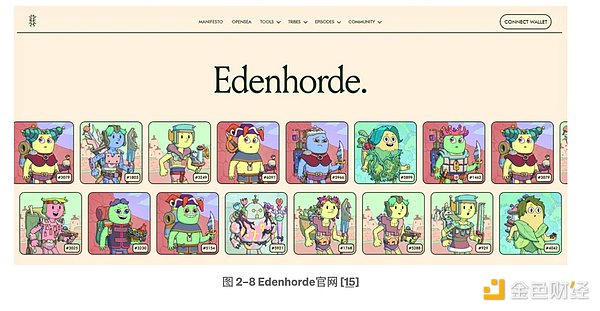
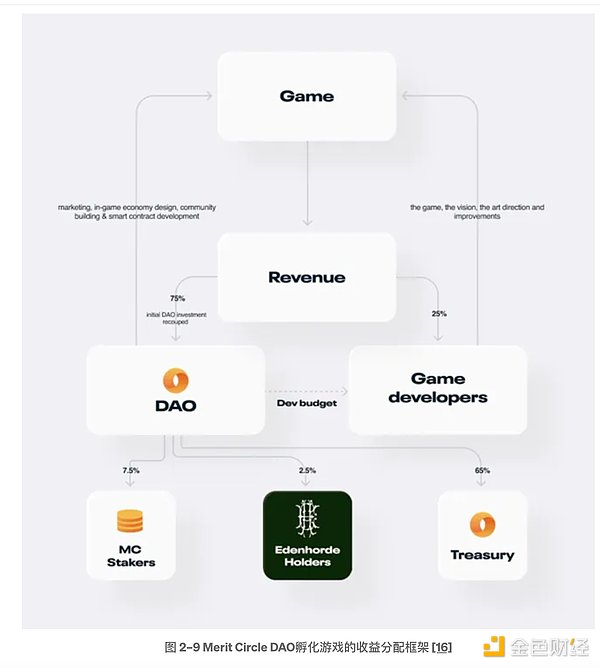
3) Merit Circle Tactile.
According to proposal MIP-22, Merit Circle Tactile is a set of 650 merchandise boxes exclusively for the community, containing seven wearable items (T-shirts, hoodies, scarves, and hats) that can be obtained by holding the Merit Circle Tactile NFT These product boxes and NFTs are distributed in two stages, and the distribution targets are proposal creators, contributors, Edenhorde NFT holders, etc.
2.4.4 Merit Circle Game
At first, Merit Circle also had a gold mining business, that is, a scholarship model. However, considering the sustainability and limitations of the scholarship business, Merit Circle decided to transform into the current gaming sector. The main functions of the current game section are: to promote cooperative games to obtain game users; to provide players with learning tutorials for major popular blockchain games; to provide early access games to Merit Circle game community users, and players receive rewards by completing tasks ( NFT, lottery, etc.).
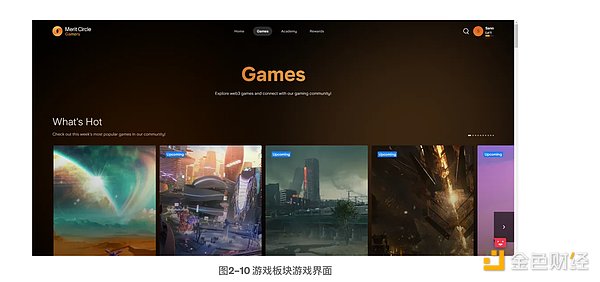
The game interface introduces popular games on the market, games available for early access, games partnered with Merit Circle, upcoming competitions, free-to-play games and game tournaments.
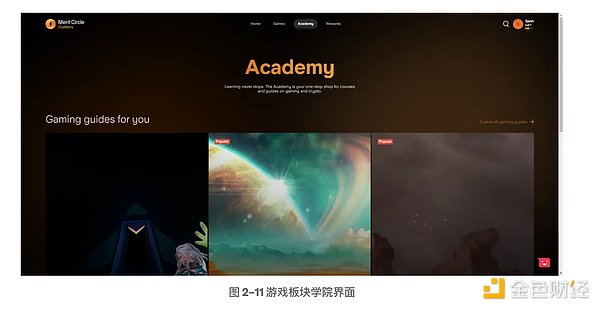
The academy provides players with introductory learning tutorials for web3, as well as learning tutorials for major popular chain games.
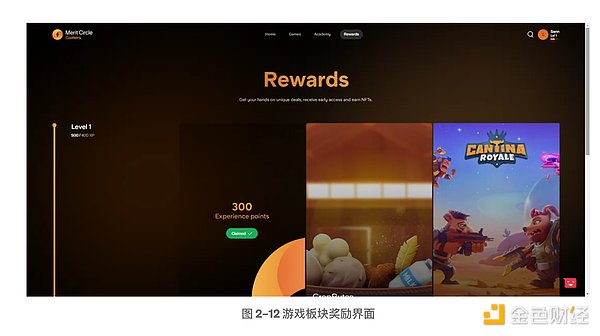
Players can gain experience points by registering an account and logging in every day. The rewards are mainly lottery draws and corresponding game-related NFTs. As the level increases, more tasks and rewards can be obtained. For example, the game that Level 1 can currently get rewards for is CropBytes. Completing these tasks within the deadline can get lottery opportunities for game NFT props.
2.4.5 Merit Circle Infrastructure
Merit Circle's infrastructure is built around games. The infrastructure product that has been released so far is the Beam game chain based on Avalanche, which was launched on the mainnet on August 18 this year. According to proposal MIP-27, 75 million $MC is allocated from the treasury (worth approximately $22.5 million based on current currency prices) to inject liquidity, provide funding to games/game developers (to pay gas fees), and verify and Securing the Beam network. In addition, 2.7 million USDC has been allocated from the treasury to develop Beam and ecosystem products (of which $200,000 is used for AMM liquidity on Beam).
Beam Game Chain adopts a POS consensus mechanism. You can become a verification node by staking $AVAX or $MC, use $MC as gas fee, use LayerZero as the official cross-chain bridge, and use Openfort to provide account abstraction wallet and integration services.
It is worth noting that according to the MIP-28 proposal, $MC may be migrated to $BEAM at a ratio of 1:100 at the end of this year ($MC will still be the platform token of the project before the migration), but the Merit Circle name will continue to be The overall brand related to the Beam network and $BEAM. After the migration, $MC is associated with outdated information in the initial stage of Merit Circle. Subsequently, $BEAM will be used as the Gas consumption and node pledge token of the Beam chain. After the migration is completed, you need to pay attention to whether there will be any major changes in the economic model.
According to official reports, the ecological games that will be released on the chain include: "Trial Xtreme", a popular motocross racing game created by Gameplay Galaxy with more than 250 million downloads; the social reasoning game "Castle of Blackwater"; and "Megaweapon" A multiplayer melee shooting game; "Walker World" is an open-world adventure and multiplayer shooting game powered by Unreal Engine 5; Merit Circle DAO and Vorto jointly launch the multiplayer online (MMO) real-time strategy (RTS) game "Hash Rush" "; "Edenhorde Eclipse", the card game incubated by Merit Circle, can be played using Edenhorde NFT; in addition, the game NFT trading market Sphere will also be launched in the future.
Summarize:
From the perspective of development route, Merit Circle has transformed into a game DAO, which is quite different from the traditional decentralized blockchain game guild. Its main product business no longer relies on the scholarship model, but through investment in the primary market of blockchain games and cooperative development Games, building chain game market distribution channel platforms, and building infrastructure have gradually expanded to the upper and middle reaches of the chain game industry.
Judging from the four major business sectors of Merit Circle, the investment sector is currently the main source of income and the core of the business, which requires focus. Merit Circle's investment style is more conservative and has a strong sense of risk. Currently, it mainly invests in the primary market of the blockchain game track. Most of the games it invests in are small games, and its current valuation has a lot of water content. Such projects The probability of survival in the bear market is not high, but the cash and highly liquid blue-chip coins in the treasury still have 45 million US dollars, accounting for 48% of the treasury, and the funds are relatively abundant; the studio sector can bring other sectors in the DAO ecosystem It is the birthplace of creative projects within Merit Circle DAO. At present, the development of the studio sector is still in its infancy. There is no obvious profit benefit at present, and the quality of innovative projects developed and incubated is relatively average; currently, the game sector Its function is similar to the distribution channel of the blockchain game market. It promotes games for game developers to acquire users, provides learning tutorials for major popular blockchain games to players in the Merit Circle game community, provides early access to games and opportunities to obtain rewards (NFT, lottery, etc.) , but for now, the game sector has no profit-making benefits and is less attractive to users; the infrastructure sector has increased the application scenarios of $MC, which may increase expectations and project ceilings. Many of the invested projects have claimed It will be released on the Beam chain, and we need to observe the implementation of the game ecology on the chain in the future.
3. Development
3.1 History

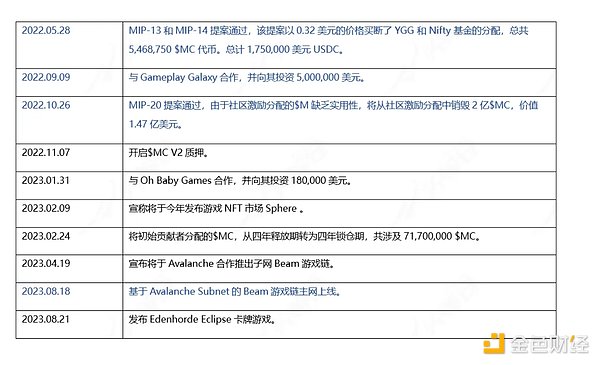
3.2 Current situation
3.2.1 Number of media followers

3.2.2 Operational data
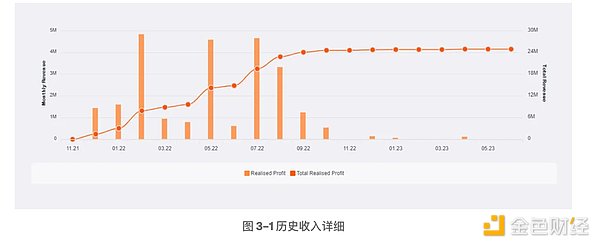
As of June 23, 2023, Merit Circle's cumulative revenue was US$24.09 million, of which the main revenue came from 2022, and its revenue in the first half of this year was only US$180,000.
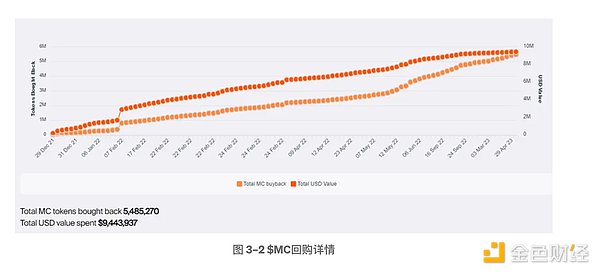
As of June 23, 2023, Merit Circle has repurchased a total of 5,485,270 $MC and spent a total of $9,443,937, accounting for approximately 39.2% of its revenue during the same period. The main repurchase time period is also 2022.

As of September 23, 2023, Merit Circle has burned a total of 368,707,273 $MC, with a cumulative value of $316,430,488, reduced from a total of 1 billion to 631,292,726. The main source of destruction is: According to the MIP7 proposal, 75% is burned every month from the community incentive distribution. of unused tokens, and 15% of investment income will be used to destroy $MC; according to the MIP-20 proposal, 200 million $MC will be destroyed from the community incentive distribution (294 million $MC) on October 26, 2022, worth $147 million;
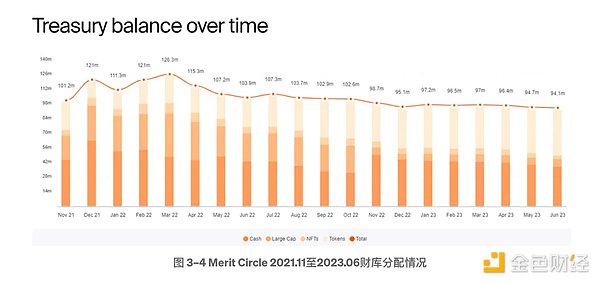
During the market downturn cycle from 2021.11 to 2023.06, Merit Circle's overall treasury shrinkage was not obvious, with a decrease of approximately 7% compared to November 2021.
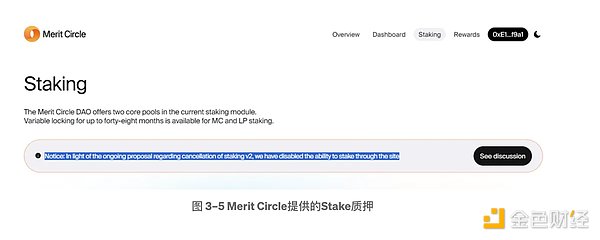
According to the MIP-19 proposal, 30,000,000 MC will be used for V2 staking rewards from November 8, 2022 to November 2023. Before the end of the year, a new staking policy vote will be held to determine rewards for the coming year. The single-coin pool obtains 20% of the liquidity mining reward distribution, and the MC/ETH pool obtains 80% of the liquidity mining reward distribution. The $MC income obtained from staking has a custom locking period, and different reward weights are allocated according to the locked time. , specific examples are: the non-locked option weight is 1; the 12-month locked option weight is 1.65; the 24-month locked option weight is 2.5; the 48-month locked option weight is 6. In addition, the $MC repurchased from investment income is also used for staking rewards.
However, according to the MIP-26 proposal on June 30 this year, Merit Circle will cancel the remaining V2 staking plan four months in advance. All stakers’ positions will be unlocked, and the accumulated $MC rewards from staking can be claimed. The remaining undistributed Approximately 9.5 million $MC will be destroyed. The project team stated that although the current staking plan was canceled and further rewards were stopped, it did not rule out the possibility of implementing new staking plans or exploring alternatives in the future.
3.3 Future
The official has not announced the latest road map.
4. Economic Model
4.1.1 Token distribution
The initial total amount of $MC was 1 billion, and the specific distribution is as follows in Table 4-1. After that, as the community voted to destroy it and part of the income was used for destruction, nearly 1/3 was destroyed. As of the time of writing, September 18, the total amount was 631,292,726 .
It is worth noting that according to the MIP-28 proposal, $MC may be migrated to $BEAM at a ratio of 1:100 at the end of this year ($MC will still be the platform token of the project before the migration), but the Merit Circle name will continue to be The overall brand related to the Beam network and $BEAM. After the migration, $MC is associated with outdated information in the initial stage of Merit Circle. Subsequently, $BEAM will be used as the Gas consumption and node pledge token of the Beam chain. After the migration is completed, you need to pay attention to whether there will be any major changes in the economic model.
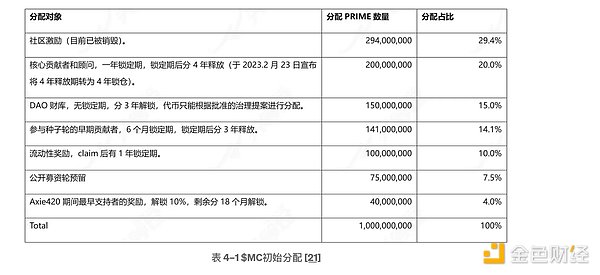
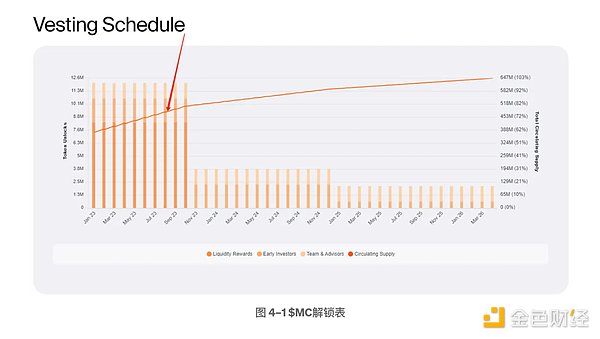
4.1.2 Analysis of currency holding addresses
According to Ethereum Browser and Nansen data, as of 2023.09.22, the total number of $MC currency holding addresses is 11,995. The top 100 $MC currency holding addresses hold 91.99%, the top 10 addresses hold 75.63%, and the top 10 addresses hold 91.99%. It mainly includes contract addresses, multi-signature address contracts, team advisor unlocking contracts, Binance hot wallets and pledge pool contracts, etc. There is no personal wallet address, and the overall positions are relatively scattered.
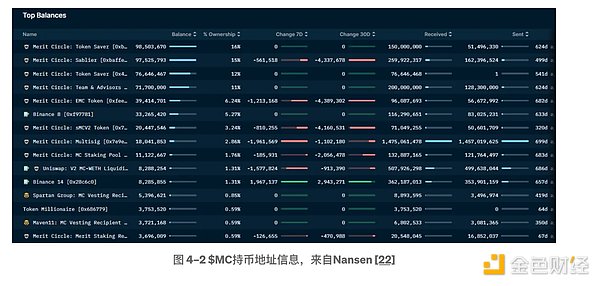
Judging from the changes in currency-holding addresses, the number of currency-holding addresses has increased significantly after October 29, 2022.

4.1.3 Governance
The major decisions of Merit Circle are basically determined by governance proposals. So far, there are 27 proposals. Here are a few important proposals: MIP-1 is publicly sold through the Balancer Labs Liquidity Bootstrapping Pool on the Copper platform, MIP-6 is in the early stage The stage risk aversion authorization proposes a series of stop-profit and stop-loss requirements, MIP-7 formulates investment allocation and destruction measures, MIP-13 and 14 buy out YGG and Nifty fund distribution for US$1.75 million, MIP-17 DAO structure restructuring, MIP- 20 Destroy $200 million MC in community incentive distribution, MIP-27 Beam development grant, etc.
Merit Circle's governance proposal terms are clear and transparent, and a governance forum has been specially created for discussion. However, the main proposals are currently proposed by the project team.
4.1.4 Token demand
1) As the Gas of Beam game and the verification node pledge;
2) Staking $MC can earn income from pre-allocated rewards and part of the income from the investment section;
3) Governance voting.
5. Competition
Merit Circle's track is the chain game guild track, but its development path is significantly different from the traditional chain game guild. Merit Circle abandoned the scholarship model and invested in the primary market of chain games, cooperated to develop games, and built The chain game market distribution channel platform, infrastructure construction and other methods have gradually expanded to the upper and middle reaches of the chain game industry.
5.1 Track Overview
In the traditional game field, game guilds are formed so that players can gather and cooperate to conquer dungeons or jointly kill big bosses. For example, in "World of Warcraft", top guilds often strive for the first clearance of each dungeon or The first kill of the monster; in addition to such cooperative guilds, traditional game guilds will also focus on social interaction between players or the sharing of game content, becoming the seat of the game community.
In Web3, due to the rise of the Gamefi track in 2021, the popularity of Axie Infinity has triggered a gold-making frenzy among blockchain players. But for most gamers in low-income countries, a pet worth 600 US dollars, The configuration cost of requiring three to start a battle is beyond the reach of many players. In this environment, the emergence of chain game guilds has greatly lowered the threshold for players to enter P2E games, among which Yield Guild Games pioneered The scholarship model led to the rise of the chain gaming guild.
The scholarship model is one of the core businesses of the chain game guild in the last round of Gamefi Summer bull market. Its operating logic is that the game guild provides the game props required by Gamefi and recruits community managers. The community managers attract new members and train gold players (scholars). Qualified players rent the game props required by Gamefi from the game guild to make gold, and the gold income earned is then distributed in proportion to the game guild and community managers.
With the development of the chain game association in the past two years, it has gradually begun to show the following characteristics:
1. Limitations of the scholarship mechanism: The scholarship mechanism essentially helps Gamefi bring more players who focus on gold farming. This group can help the game attract popularity and expand the game community in the early stages. However, once it enters the middle and late stages, it will At present, the design of the general token model in the chain game circuit is immature, and death spiral dilemmas abound. The huge gold users and chain game guilds that focus on game assets (NFT game props) are extremely harmful to the game itself. Seriously, it will accelerate the collapse of the Gamefi economic model.
This means that the operation of the scholarship system cannot last long in a single Gamefi. Guilds need to constantly look for profitable Gamefis to make profits. During the bear market, there are not many profitable Gamefis, which will lead to Guilds may experience significant cyclical changes in their revenue;
In addition, the current general scholarship mechanism of the chain game guild only applies to P2E mode games, and P2E mode games, without exception, are currently entering a recession stage. In the long term, will P2E mode chain games continue to exist? Death is difficult to determine.
As the development of the Gamefi track gradually matures, more and more Gamefis have begun to have their own rental systems, such as Starshark and Pegaxy; the emergence of the rental system will also squeeze the audience players of the scholarship system. Once more If players choose to use the leasing system instead of using a shared scholarship system like YGG, the income of this type of guild will drop significantly.
2. The regional nature of guilds is serious: the current mainstream guilds are mainly distributed in Southeast Asia. For example, YGG, the largest guild in the track, has its main community players in the Philippines and is committed to developing Gaas (Guild-As-a-Service). )’s GuildFi main community is located in Thailand, while the largest chain game guild in Vietnam is Ancient8.
3. Future development will be funded and functional: After the success of the scholarship model, guilds began to look for the next "Axie Infinity". Therefore, guilds now generally participate in the early NFT pre-sales of chain game projects and are committed to passing the early Cooperate to obtain a certain amount of NFT to prepare for the later launch of the game;
In addition to NFT, the Guild will even serve as an early venture investor in many chain game projects, transforming its role from an NFT leasing intermediary and player community to a venture capital fund for the chain game track; in addition to the direction of funding, there are also The guild is trying to explore other development directions, such as developing infrastructure, incubating and developing games, providing data services, community services, diversion services for cooperative projects, and providing systematic management services for the guild’s scholarship system and income system, that is, towards functional development in an end-oriented direction.
4. Highly dependent on the development of the chain game circuit: Whether the income of the chain game guild relies on the commission from the scholarship mechanism or the rate of return on investment in Gamefi, both are based on the development of the chain game circuit. Chain games The track is still in its early stages, and there is a lot of room for growth in the future. As a game guild, it is crucial to be able to grow with the track and ensure that the value of its investment portfolio can continue to be profitable.
5.2 Comparison of competing products
1) Yield Guild Games (YGG)
YGG is a decentralized chain game guild built on ETH and Polygon. It pioneered the scholarship model and led to the rise of the chain game guild track. However, due to the current desertedness of the chain game track, the limitations of the scholarship model have gradually been exposed. On the development path, YGG began to invest in high-quality games instead of pure P2E game development. At first, Merit Circle was a scholarship guild similar to YGG. It also had scholarship business, SubDao model, etc. However, considering the sustainability and limitations of the scholarship business, and the fact that these businesses were almost all suppressed by YGG, it began to transform in March 2022. The structure and positioning of DAO hope to build Merit Circle into a game DAO.
2) GuildFi (GF)
GF is a chain game guild and guild service platform built on Ethereum. Currently, the project is trying to develop in the direction of funding and functionality, providing early financing for the game community and guild-related services after launch.
5.2.1 Competitive product business development
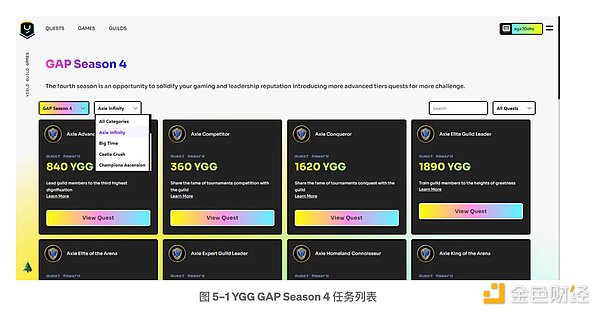
YGG's current focus is on cooperating with popular games and related projects, investing in and incubating track-related games, guilds, and infrastructure, and organizing web3 micro-sports competitions and activities to continue to expand the community. The once core scholarship business has been in 22 years. It shows a reduction in each quarter, and no data related to scholarship business was released in the community reports of Q1 and Q2 this year.
At present, the main way of YGG community operation is the Quest game task system. Currently, it is mainly through launching the GAP program (Guild Advancement Program) to expand the community and enhance community cohesion, and promote the collaboration between community members and cooperative games. Participants need to complete the official release of YGG Achievement tasks, such as participating in cooperative games for a corresponding length of time; recruiting a corresponding number of players to join YGG, hosting high-quality streaming content, etc. to receive YGG token rewards and corresponding NFTs. This plan is one of the key directions of YGG's current development, and GAP Season 4 is currently underway. As shown in Figure 5-1 below, GAP Season 4 provides a total of 14 mission sets, with a total of more than 150 missions. However, these missions need to be completed with higher difficulty. For players who can complete these missions, the income is low and they are all $YGG. Bonus, overall appeal is weak. But compared to the NFT rewards and draws provided by Merit Circle’s game section, YGG’s Quest rewards will be more generous.
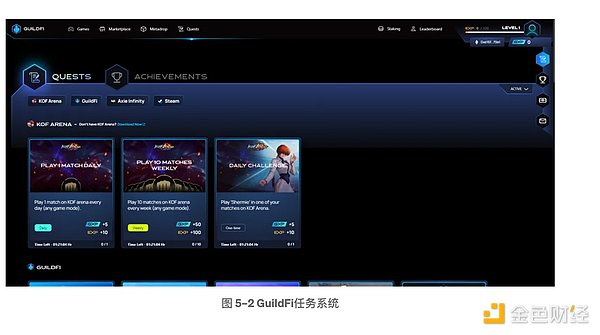
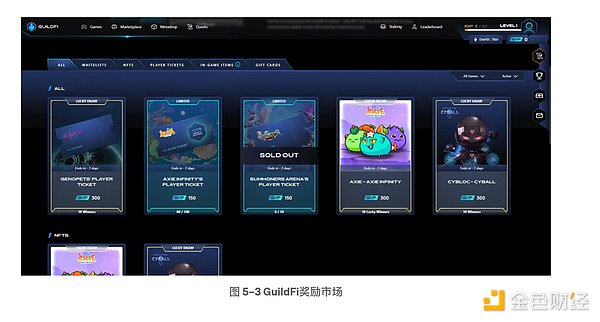
GuildFi's current community operation method is mainly through the task system and reward market. Players complete the provided tasks to obtain certain GXP points, which can be used to exchange for game whitelist qualifications, game NFT, game tickets, in-game items and gift cards, etc. ( Mainly Axie Infinity), there are fewer categories that can be redeemed and the value is lower.

From the perspective of community scale and community operations, the community foundations of Merit Circle and GuildFi are relatively weak due to the lack of attractive gold mining business and community activities. YGG has a first-mover advantage and has accumulated a certain community foundation with its previous scholarship model and SubDAO mechanism. But for now, all three are lacking in their ability to attract new users and retain old ones.
5.1.2 Comparison of financial data
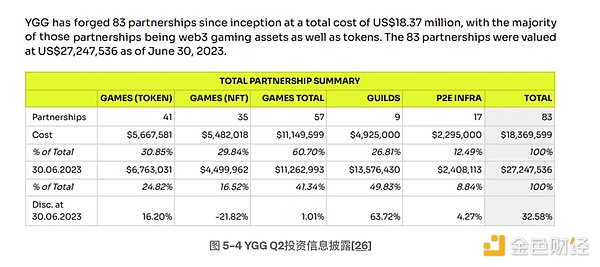
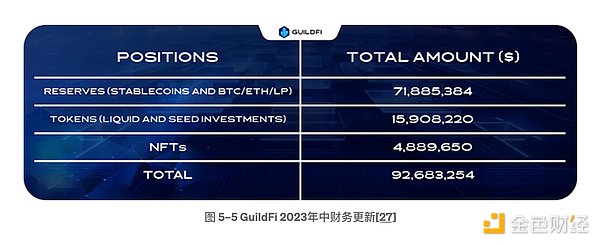
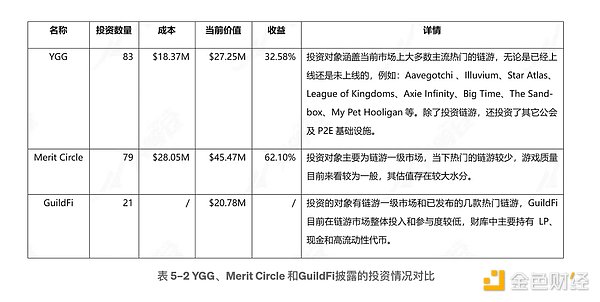
YGG disclosed financial information in the 2023Q2 community update document. From its establishment to 2023Q2, YGG invested in a total of 83 projects related to the chain game track, of which the investment objects were 41 game tokens, 35 game NFT assets, 57 games, 9 chain game guilds and 17 P2E infrastructure. The cost of investment in these projects is US$18.37 million. As of June 30, 2023, the value of these investments is approximately US$2,725, with a profit of approximately 32.58%. In addition to its own treasury investment, YGG also raised US$75 million on February 18 this year to establish a venture capital fund called YGG Ventures Fund I, which is used to invest in web3, game studios and infrastructure to support industry development. of early token and equity transactions.
As of June 23, 2023, Merit Circle's treasury size is US$94.1 million, which is divided into four parts, as follows: cash accounts for 40%, and the allocation is mainly USDC; blue chip coins account for 8%, mainly WBTC, Uni V2 pledge and WETH; NFT assets account for 4%, mainly Bigtime Land (USD 1 million), Axies NFT and Cyball NFT; tokens/equities related to the chain game track account for 48%, with a total of 79 projects invested (61 non-circulating , 18 in circulation), which is mainly the primary market of chain games, accounting for about 80% of the token/equity investment related to the chain game track.
In terms of investment performance, compared with YGG and GuildFi, Merit Circle looks better on the surface. However, in fact, most of the projects Merit Circle invests in are uncirculated equity. Judging from the quality of the current invested projects, its valuation is generally weak. Larger, this means that the actual investment situation of Merit Circle is likely to cause more losses, although the specific losses are difficult to calculate. However, Merit Circle does have better risk control capabilities and larger capital scale, as well as relatively transparent financial information disclosure (monthly updates, public billboards). Looking back at GuildFi, its overall investment and participation in the chain game market is low, its competitiveness is also weak, and it is quite a situation of sitting flat on interest; in terms of cooperation and investment objects, compared with Merit Circle and GuildFi, YGG has The quality of games invested and cooperated with is more advantageous and has better brand effect.
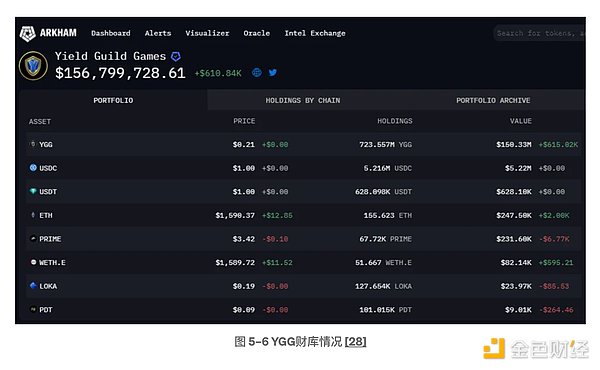
YGG's treasury currently holds tokens worth $157 million, of which approximately $724 million is held by YGG. The current value is $150 million, accounting for 95.54%. The current value of stablecoins and other circulating tokens is $7 million. The proportion is 4.46%.
Merit Circle disclosed that its treasury size was US$94.1 million as of June 23, 2023, of which stablecoins and blue-chip coins are worth approximately US$45 million. According to the official treasury wallet address, Merit Circle's treasury addresses on Ethereum and BSC hold a total of approximately 42.49 million $MC, which is approximately 12.83 million US dollars based on the current currency price, accounting for approximately 9.17% of the current total circulation. .
In its mid-year report released on July 26 this year, GuildFi stated that its total treasury funds were approximately US$92.68 million, divided into three parts. Stablecoins, BTC, ETH and LP were approximately US$71.89 million. The investment tokens and The primary market is approximately US$15.91 million, and the NFT assets held are US$4.89 million. But in fact, based on the current announced address holdings on the five treasury chains, it was found that its total funds are approximately US$42.26 million, of which $GF tokens are worth approximately US$7.35 million, and most of the rest are stablecoins, ETH and LP. . In addition, there were two transfers from the main treasury address to Binance, with amounts of 8 million USDT and 2.97 million USDT respectively. According to the official statement, these funds are mainly used to support daily operations and repurchase tokens from investors. .
Judging from the treasury situation, YGG holds a large amount of $YGG in the treasury, accounting for 95.54%, and holds only US$7 million in stable coins and other liquid tokens, accounting for only 4.46%. On the other hand, the treasury distribution of Merit Circle and GuildFi is more reasonable. The former’s stable and blue-chip coins account for nearly 50%, with a value of approximately US$45 million. The latter holds approximately 71.9% of stable and blue-chip coins, worth approximately US$53.23 million. In addition, Merit Circle’s token $MC has a higher unlocked circulation ratio, about 73.32% ($YGG is 18.51%, $GF is 42.56%). It also has a token destruction and repurchase mechanism, with a total of 368,707,273 $ destroyed so far. MC, repurchase 5,485,270 $MC, and $MC can also be used as Beam's gas consumption and node pledge, while YGG and GuildFi currently have no token destruction and repurchase mechanisms, and their token empowerment is weaker than $MC. .
The market values of cash plus high-liquidity tokens in the treasury of Merit Circle and GuildFi are similar, but the market value of the two is quite different. The current liquid market value of $GF is approximately US$20.38 million, and the fully circulated market value is approximately US$47.86 million, both of which are lower than the current total amount of funds in its treasury of US$74 million (5323+ mid-year reported NFT and investment project value). The circulating market value of $MC is approximately US$140 million, and the fully circulated market value is approximately US$195 million, both of which are higher than the current total amount of funds in its treasury this year, which is US$94.1 million. The reasons may be inferred as follows:
① Although the cash flows of Merit Circle and GuildFi are close and the quality of the projects invested by both is relatively average, Merit Circle’s investment scale is larger, indicating that it is more actively involved in the layout and industry, while GuildFi has the tendency to stay away from the track and lie flat. With the interest rate situation, it may be difficult for GF to get on board when the track heats up, and if the bear market continues for a long time, it may be an advantage for GuildFi.
② Merit Circle is actively developing chain gaming infrastructure. Although MC’s infrastructure development is still in its infancy, this positioning change reflects its willingness to expand the business scope of the track. However, considering that the development is still in its early stages, it cannot be ruled out. Its high market value may be overly optimistic and may lead to speculation. Over time, if Merit Circle’s investment business and infrastructure do not develop as expected, its valuation advantage compared to GuildFi may be reduced.
③ $MC has a destruction and repurchase mechanism, as well as Gas consumption and node staking as a Beam chain, and the overall token empowerment is better than $GF.
Summarize:
The current scale of the chain game guild track is not large, and the community size is not even comparable to the user scale of popular chain games. The scale of the entire track still has a lot of room for growth;
YGG has maintained a high growth rate by expanding the community and cooperating with popular games, and is the first choice for the most prestigious guild in the circuit. Merit Circle is actively expanding its business scope and exploring more possibilities through transformation and multi-faceted layout in the upstream and midstream of chain games, but it is still in its infancy and needs time to be verified. However, GF's development is relatively flat and somewhat off-track. Its investment scale is limited and it mainly focuses on earning interest, so its influence in the industry is weak.
6. Risks
1) Judging from the investment situation, Merit Circle invests mostly in the primary market of chain games, accounting for approximately 80% of the token/equity investments related to the chain game track. Merit Circle's income method is relatively single, mainly relying on the investment sector. Most of the gamefis invested by Merit Circle are small games, and the market value of the investment part is relatively large. The survival rate of this type of chain games in the bear market is low, and the risks and uncertainties are Greater certainty. Merit Circle's short- and medium-term revenue situation is difficult to improve due to market conditions. The follow-up depends on the development of the chain game track and whether the games invested can have good returns, as well as whether the constructed Beam game chain and the soon-to-be-released game NFT market Sphere can have good returns. good development.
2) The market value of $MC has a strong correlation with the market value of treasury assets under management, and the ceiling expectations appear to be relatively limited for the time being.
3) Due to the lack of attractive gold mining business and community activities, Merit Circle’s community foundation is relatively weak.





